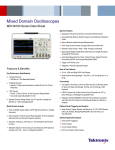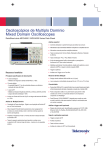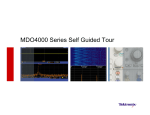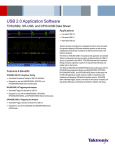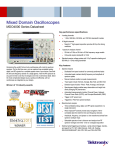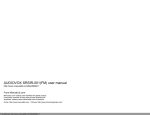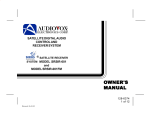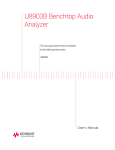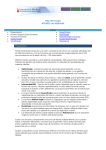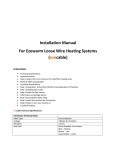Download MDO4000 Series Declassification and Security
Transcript
xx ZZZ MDO4000 Series Oscilloscopes Declassification and Security Instructions www.tektronix.com *P077058400* 077-0584-00 Copyright © Tektronix. All rights reserved. Licensed software products are owned by Tektronix or its subsidiaries or suppliers, and are protected by national copyright laws and international treaty provisions. Tektronix products are covered by U.S. and foreign patents, issued and pending. Information in this publication supersedes that in all previously published material. Specifications and price change privileges reserved. TEKTRONIX and TEK are registered trademarks of Tektronix, Inc. TekSecure is a trademark of Tektronix, Inc. Contacting Tektronix Tektronix, Inc. 14150 SW Karl Braun Drive P.O. Box 500 Beaverton, OR 97077 USA For product information, sales, service, and technical support: In North America, call 1-800-833-9200. Worldwide, visit www.tektronix.com to find contacts in your area. Table of Contents Preface .............................................................................................................................................................. iii Clear and Sanitize Procedures..................................................................................................................................... 1 Memory Devices............................................................................................................................................... 2 Data Export Devices........................................................................................................................................... 4 Built-In Security Features ......................................................................................................................................... 5 Disable the LAN Port and Clear LAN Ethernet Settings.................................................................................................. 7 Disable the USB Device Port................................................................................................................................. 8 Clear and Sanitize a Nonfunctional Instrument ................................................................................................................. 9 MDO4000 Series Declassification and Security Instructions i Table of Contents ii MDO4000 Series Declassification and Security Instructions Preface If you have data security concerns, this document helps you to sanitize or remove memory devices from the Tektronix MDO4000 Series Mixed Domain Oscilloscopes. The MDO4000 Series products have data storage (memory) devices and data output devices (USB ports). These instructions tell you how to clear or sanitize the memory devices, and also tell you how to declassify an instrument that is not functioning. Instrument code and calibration settings reside in nonvolatile flash memory. Instrument setups and reference waveforms may also be stored in flash memory or on USB drives connected to the instrument. If you have any questions, contact the Tektronix Technical Support Center at www.tektronix.com/support. Reference The procedures in this document are written to meet the requirements specified in: NISPOM, DoD 5220.22–M, Chapter 8 ISFO Process Manual for Certification & Accreditation of Classified Systems under NISPOM Products The following Tektronix products are covered by this document: MDO4104-6 MDO4104-3 MDO4054-6 MDO4054-3 Related Documents The Tektronix MDO4000 Series Mixed Domain Oscilloscopes Service Manual, part number 077-0585-XX, is available on the Tektronix Web site at www.tektronix.com/manuals. MDO4000 Series Declassification and Security Instructions iii Preface Terms The following terms may be used in this document: Clear. This removes data on media/memory before reusing it in a secured area. All reusable memory is cleared to deny access to previously stored information by standard means of access. Demo setups. These setups come loaded in the instrument, and cannot be modified by the customer. Erase. This is equivalent to clear. Instrument Declassification. A term that refers to procedures that must be undertaken before an instrument can be removed from a secure environment. Declassification procedures include memory sanitization and memory removal, and sometimes both. Media storage/data export device. Any of several devices that can be used to store or export data from the instrument, such as a USB port. Nonvolatile memory. Data is retained when the instrument is powered off. Power off. Some instruments have a “Standby” mode, in which power is still supplied to the instrument. For the purpose of clearing data, putting the instrument in Standby mode does not qualify as powering off. For these products, you will need to remove the power source from the instrument. Protected user data area. Contains data that is protected by a password. Remove. This is a physical means to clear the data by removing the memory device from the instrument. Instructions are available in the product Service Manual. Sanitize. This eradicates the data from media/memory so that the data cannot be recovered by other means or technology. This is typically used when the device will be moved (temporarily or permanently) from a secured area to a nonsecured area. Scrub. The user is able to directly retrieve the memory device contents. User-modifiable. The user can write to the memory device during normal instrument operation, using the instrument interface or remote control. Volatile memory. Data is lost when the instrument is powered off. iv MDO4000 Series Declassification and Security Instructions Clear and Sanitize Procedures The following terms are used in the tables in this section: Type of User Info Stored This column describes the type of user information that is stored in the device: User data. Waveforms and other measurement data that represent signals that users connect to the instrument. User settings. Instrument settings that the user can change. Both. Both user data and user settings are stored in the device. None. Neither user data nor user settings are stored in the device. Method of Modification This column indicates the method of modifying data: Direct. The user can modify the data. Indirect. The instrument system resources modify the data. The user cannot modify the data. User Accessible This column indicates whether the user can retrieve the device contents: Yes. The user can directly retrieve the memory device contents. No. The user cannot retrieve the memory device contents. To Clear This column tells how to clear data from the media or memory device before reusing it in a secured area. All reusable memory is cleared to deny access to previously stored information by standard means of access. To Sanitize This column tells how to eradicate the data from the media or memory device so that the data cannot be recovered by other means or technology. This is typically used when the device will be moved (temporarily or permanently) from a secured area to a nonsecured area. MDO4000 Series Declassification and Security Instructions 1 Clear and Sanitize Procedures Memory Devices The following tables list the volatile and nonvolatile memory devices in the standard instrument and listed options. Detailed procedures to clear or sanitize these devices, if any, are shown following each table. Table 1: Volatile memory devices Type and minimum size Backed up by battery Method of modification Data input method Location User accessible To clear To sanitize CMOS, SDRAM, 64M X 16, 400 Mb DDR2, 1.8 V, 1024 MHz (EFFECTIVE 800 MHz); MT47H64M16HR-25E REBAL Contains waveform main data during operation Both No Indirect Front panel control and oscilloscope input channels Main Acquisition board No Remove power from the instrument for at least 20 seconds Remove power from the instrument for at least 20 seconds CMOS, SDRAM, 64M x 16, 1024 Mb DDR2, 1.8 V, 400 MHz (Effective 800 MHz); MT47H64M16HR-25E Contains instrument code and data during operation Both No Indirect Front panel control and oscilloscope input channels. Data inputs through USB port and Ethernet port. Main acquisition board No Remove power from the instrument for at least 20 seconds Remove power from the instrument for at least 20 seconds CMOS, SDRAM, 64M x 16, 1024 Mb DDR2, 1.8 V, 400 MHz (Effective 800 MHz); MT47H64M16HR-25E Contains display images during operation Both No Indirect Front panel control and oscilloscope input channels. Main acquisition board No Remove power from the instrument for at least 20 seconds Remove power from the instrument for at least 20 seconds CMOS, DRAM; 4M X 32,128 Mb, SDRAM, 3.3 V; MT48LC4M32B2B\5-7, 90-BALL FBGA (11 MM X 13 MM), DS4 Contains code for digital waveform processor None No Indirect System Main acquisition board No Remove power from the instrument for at least 20 seconds Remove power from the instrument for at least 20 seconds CMOS, DRAM; 16M x 16, 256 Mb, SDRAM, 3.3 V; MT48LC16M16A2TG-8E, TSOP54 Contains digital waveform acquisition memory Both No Indirect Front panel control and digital input channels Main acquisition board No Remove power from the instrument for at least 20 seconds Remove power from the instrument for at least 20 seconds 2 Function Type of user info stored MDO4000 Series Declassification and Security Instructions Clear and Sanitize Procedures Table 2: Nonvolatile memory devices Type and minimum size Function Type of user info stored Method of modification Data input method Location User accessible To clear To sanitize CMOS, EEPROM; 128 X 8, SERIAL; 24C01A, SOIC8 Contains PowerPC hardware configuration None Indirect System Main acquisition board No Not applicable - no user data or settings Not applicable - no user data or settings CMOS, FLASH; C, 512 Mb, 150 NS, 3 V, StrataFlash; PC48F4400P0TB00A, BGA64 Contains the instrument firmware, calibration constants, reference waveforms, and instrument setups Both Indirect Front panel control and oscilloscope input channels. Data inputs through USB port and Ethernet port. Main acquisition board User can access only the reference part; not the program Not applicable for calibration constants. Not applicable for calibration constants. Use TekSecure to clear reference waveforms and instrument setups. Use TekSecure to clear reference waveforms and instrument setups. (See page 5.) (See page 5.) You can disable the LAN Ethernet and clear information, such as IP addresses. (See page 7.) You can disable the LAN Ethernet and clear information, such as IP addresses. (See page 7.) You can disable the USB Device port. (See page 8.) You can disable the USB Device port. (See page 8.) MDO4000 Series Declassification and Security Instructions 3 Clear and Sanitize Procedures Data Export Devices The following table lists the data export devices. Table 3: Data export devices Method of modification Data input method Supports the removable USB flash drive; user storage of reference waveforms, screen images, and instrument setups Direct System resources Ethernet User storage of reference waveforms, screen images, and instrument setups. Direct System resources LAN port on rear of instrument Yes Disconnect from network cable. The Ethernet port can be disabled. (See page 7.) USB device port Supports remote control and data transfer to a PC Direct Remote control via USBTMC USB device port on rear of instrument No The USB Device port can be disabled. (See page 8.) Type Function USB host ports 4 Location User accessible To disable USB host ports on the front and rear of the instrument Yes Files can be deleted or overwritten on the instrument or a PC; the USB flash drive can be removed and destroyed. The USB host ports cannot be disabled. MDO4000 Series Declassification and Security Instructions Built-In Security Features You can use the TekSecure function to erase setup and reference waveform data stored in internal flash memory. The MDO4000 Series models have four USB host ports (two on the front and two on the rear panel) and one USB device port on the rear panel. Any USB devices can be removed and stored or destroyed. What TekSecure Does NOTE. TekSecure does not erase or change factory calibration constants, Ethernet settings, Demo setups, or protected user data. To overwrite protected user data, use the provided procedure. (See page 6, To Overwrite Protected User Data.) The TekSecure function does the following: Replaces all waveforms in all reference memories with null sample values Replaces the current front-panel setup and all stored setups (except Demo setups) with the default setup values Calculates the checksums of all reference waveform memory and setup memory locations to verify successful completion of waveform and setup erasure Displays a dialog box indicating whether the secure erase was successful or unsuccessful To Use TekSecure 1. Push the front-panel Utility button. 2. Push the Utility Page lower-bezel button and use the Multipurpose a knob to select Config. 3. Push the TekSecure Erase Memory lower-bezel button. 4. Push the OK Erase Setup and Ref Memory side-bezel button. Wait for the “TekSecure operation complete” dialog box to display. 5. Push the Menu Off front-panel button to close the dialog box. MDO4000 Series Declassification and Security Instructions 5 Built-In Security Features To Reset the Instrument RAM To Overwrite Protected User Data 1. Power off the instrument. 2. Power on the instrument. This procedure overwrites everything that is stored in the protected user data area. Send the following commands to the oscilloscope: :PASSWORD “XYZZY” (or current password if changed from the default of “XYZZY”) :NEWPASS “ANYTHING” :PASSWORD “ANYTHING” *PUD #3300xxxxxxxxxxxxxxxxxxxxxxxxxxxxxxxxxxxxxxxxx[repeat for a total of 300 x’s] NOTE. If you do not have access to a program that supports sending programmatic commands to the instrument, copy the preceding commands to a text file that ends in “.set” and recall the file from the Recall Setup menu. For more information on using programming commands, refer to the MDO4000 Mixed Domain Oscilloscopes Programmer Manual, Tektronix part number 077-0510-XX, available at www.tektronix.com/manuals. 6 MDO4000 Series Declassification and Security Instructions Built-In Security Features Disable the LAN Port and Clear LAN Ethernet Settings To disable the LAN port and clear LAN Ethernet settings, such as IP addresses, follow these steps: CAUTION. Write down all setting values before clearing them, to enable you to restore network connectivity later. 1. Remove the network cable from the LAN port on the rear of the instrument. 2. Push the front-panel Utility button. 3. Push the Utility Page lower-bezel button and use the Multipurpose a knob to select I/O. 4. Clear the passwords as follows: a. Push the Ethernet & LXI lower-bezel button. b. Push the E*Scope Password right-bezel button. c. Use the Multipurpose a knob to select Disabled. d. Push the Change E*Scope & LXI Password right-bezel button. e. Push the Clear lower-bezel button. f. Push the OK Accept right-bezel button. 5. Clear the IP addresses as follows: a. Push the Network Configuration lower-bezel button. b. Push the Set IP Addresses Manually size-bezel button. c. Select the Instrument IP Address by pushing the ↑ or ↓ arrow side-bezel button, and then push the Clear lower-bezel button. MDO4000 Series Declassification and Security Instructions 7 Built-In Security Features d. Select and clear the remaining addresses (Gateway IP, Subnet Mask, and DNS IP Address). e. Push the OK Accept right-bezel button. 6. Clear the user and domain names as follows: a. Push the Ethernet & LXI lower-bezel button. b. Push the Change Names right-bezel button. c. Clear the Host Name and Domain Name using the same method that you used to clear the IP addresses. d. Push the OK Accept right-bezel button. The LAN system is disabled and no longer allows data traffic in or out. The relevant LAN Ethernet settings are also cleared. Disable the USB Device Port To disable the USB device port, follow these steps: 1. Remove any USB cable or device from the USB device port on the rear of the instrument. 2. Push the front-panel Utility button. 3. Push the Utility Page lower-bezel button and use the Multipurpose a knob to select I/O. 4. Push the USB lower-bezel button. 5. Push the Disabled (Off Bus) side-bezel button to disable the USB device port. Note that the USB lower-bezel button shows “Disabled.” The USB device port is disabled and no longer allows data traffic in or out. 8 MDO4000 Series Declassification and Security Instructions Clear and Sanitize a Nonfunctional Instrument If your instrument is not functioning and you need to clear or sanitize it, proceed as follows: NOTE. The Analog board must be calibrated with the Main board by Tektronix. Please contact Tektronix before returning your instrument. 1. Remove the USB flash drive from your oscilloscope. Refer to your company's internal policies regarding handling or disposal of the flash drive. 2. Remove the Main board from your oscilloscope. For removal instructions, refer to the Tektronix MDO4000 Series Mixed Domain Oscilloscopes Service Manual, part number 077-0585-XX, which is available on the Tektronix Web site at www.tektronix.com/manuals. Refer to your company's internal policies regarding handling or disposal of the board. 3. Return the oscilloscope to Tektronix. A new Main board will be installed, and the oscilloscope will be repaired. The oscilloscope will be adjusted as necessary, which includes adjusting (calibrating) the new Main board and the Analog board together. 4. Replacement of any missing hardware will be charged according to the rate at the time of replacement. MDO4000 Series Declassification and Security Instructions 9















